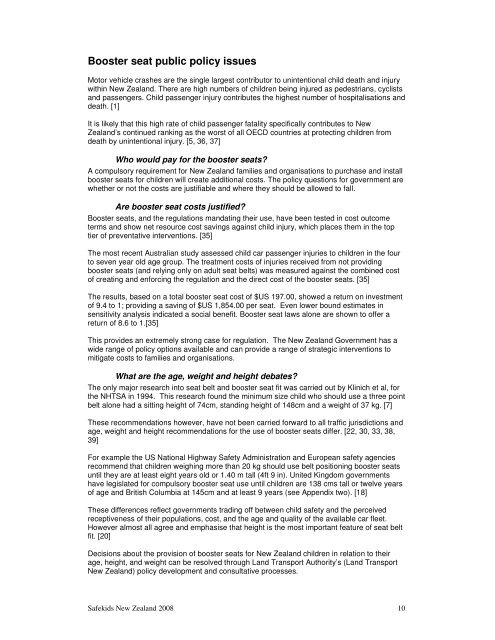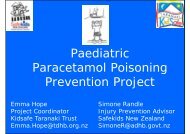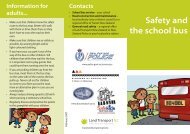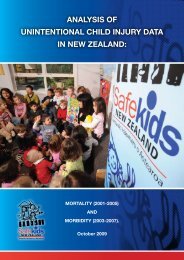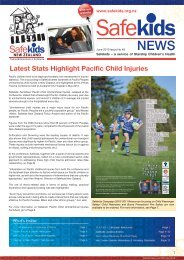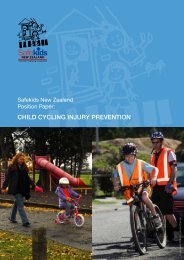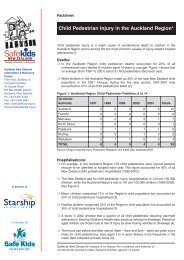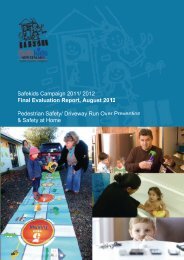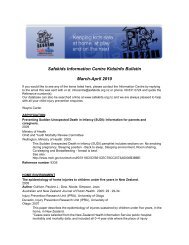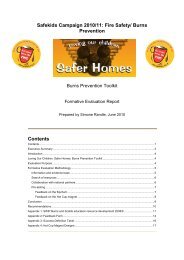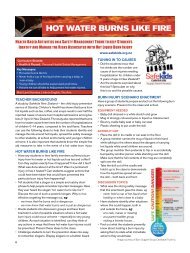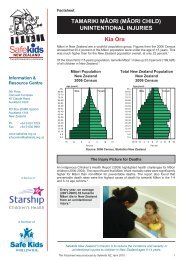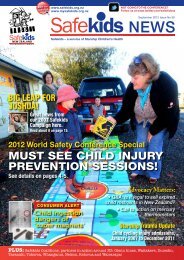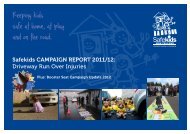Summary It's booster seat time for Kiwi kids - Safekids
Summary It's booster seat time for Kiwi kids - Safekids
Summary It's booster seat time for Kiwi kids - Safekids
Create successful ePaper yourself
Turn your PDF publications into a flip-book with our unique Google optimized e-Paper software.
Booster <strong>seat</strong> public policy issues<br />
Motor vehicle crashes are the single largest contributor to unintentional child death and injury<br />
within New Zealand. There are high numbers of children being injured as pedestrians, cyclists<br />
and passengers. Child passenger injury contributes the highest number of hospitalisations and<br />
death. [1]<br />
It is likely that this high rate of child passenger fatality specifically contributes to New<br />
Zealand’s continued ranking as the worst of all OECD countries at protecting children from<br />
death by unintentional injury. [5, 36, 37]<br />
Who would pay <strong>for</strong> the <strong>booster</strong> <strong>seat</strong>s?<br />
A compulsory requirement <strong>for</strong> New Zealand families and organisations to purchase and install<br />
<strong>booster</strong> <strong>seat</strong>s <strong>for</strong> children will create additional costs. The policy questions <strong>for</strong> government are<br />
whether or not the costs are justifiable and where they should be allowed to fall.<br />
Are <strong>booster</strong> <strong>seat</strong> costs justified?<br />
Booster <strong>seat</strong>s, and the regulations mandating their use, have been tested in cost outcome<br />
terms and show net resource cost savings against child injury, which places them in the top<br />
tier of preventative interventions. [35]<br />
The most recent Australian study assessed child car passenger injuries to children in the four<br />
to seven year old age group. The treatment costs of injuries received from not providing<br />
<strong>booster</strong> <strong>seat</strong>s (and relying only on adult <strong>seat</strong> belts) was measured against the combined cost<br />
of creating and en<strong>for</strong>cing the regulation and the direct cost of the <strong>booster</strong> <strong>seat</strong>s. [35]<br />
The results, based on a total <strong>booster</strong> <strong>seat</strong> cost of $US 197.00, showed a return on investment<br />
of 9.4 to 1; providing a saving of $US 1,854.00 per <strong>seat</strong>. Even lower bound estimates in<br />
sensitivity analysis indicated a social benefit. Booster <strong>seat</strong> laws alone are shown to offer a<br />
return of 8.6 to 1.[35]<br />
This provides an extremely strong case <strong>for</strong> regulation. The New Zealand Government has a<br />
wide range of policy options available and can provide a range of strategic interventions to<br />
mitigate costs to families and organisations.<br />
What are the age, weight and height debates?<br />
The only major research into <strong>seat</strong> belt and <strong>booster</strong> <strong>seat</strong> fit was carried out by Klinich et al, <strong>for</strong><br />
the NHTSA in 1994. This research found the minimum size child who should use a three point<br />
belt alone had a sitting height of 74cm, standing height of 148cm and a weight of 37 kg. [7]<br />
These recommendations however, have not been carried <strong>for</strong>ward to all traffic jurisdictions and<br />
age, weight and height recommendations <strong>for</strong> the use of <strong>booster</strong> <strong>seat</strong>s differ. [22, 30, 33, 38,<br />
39]<br />
For example the US National Highway Safety Administration and European safety agencies<br />
recommend that children weighing more than 20 kg should use belt positioning <strong>booster</strong> <strong>seat</strong>s<br />
until they are at least eight years old or 1.40 m tall (4ft 9 in). United Kingdom governments<br />
have legislated <strong>for</strong> compulsory <strong>booster</strong> <strong>seat</strong> use until children are 138 cms tall or twelve years<br />
of age and British Columbia at 145cm and at least 9 years (see Appendix two). [18]<br />
These differences reflect governments trading off between child safety and the perceived<br />
receptiveness of their populations, cost, and the age and quality of the available car fleet.<br />
However almost all agree and emphasise that height is the most important feature of <strong>seat</strong> belt<br />
fit. [20]<br />
Decisions about the provision of <strong>booster</strong> <strong>seat</strong>s <strong>for</strong> New Zealand children in relation to their<br />
age, height, and weight can be resolved through Land Transport Authority’s (Land Transport<br />
New Zealand) policy development and consultative processes.<br />
Safe<strong>kids</strong> New Zealand 2008 10


